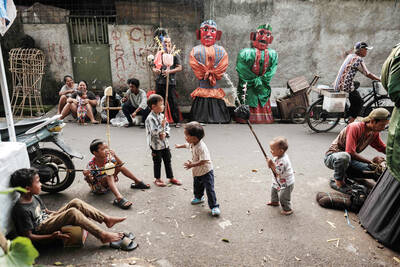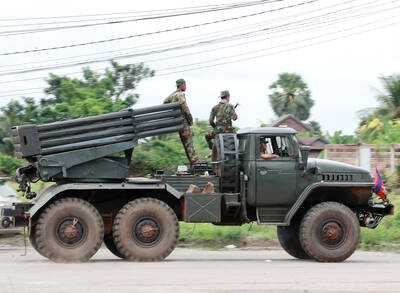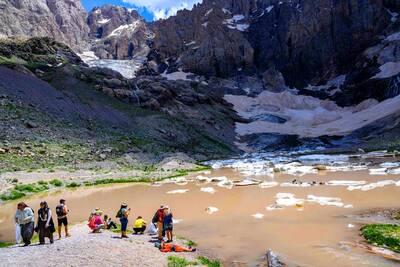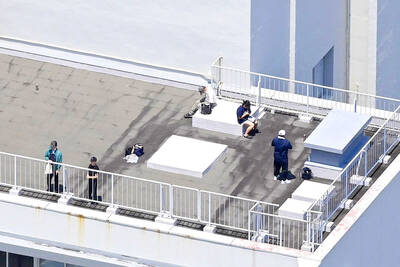Its creator has called it a “virtual time machine” — a digital reconstruction of ancient Rome that became available to Internet users around the world this week.
Users of Google Earth can now see the city, down to the last aqueduct and arena, as it looked at noon on April 1 320AD. They can navigate through the Forum, past the platform or rostra from which Cicero once declaimed, admire the statues, read the inscriptions, pry into palaces, and then slip round to the Colosseum or whisk over to the Circus Maximus where the ancient Romans held their chariot races.
There, the virtual traveler will find not the slightly disappointing, enormous oval expanse of grass that confronts the real tourist, but the huge, walled stadium that they are forced to conjure up from their imagination.
It is the “Rome of [the emperor] Constantine in which everything is new”, said Google Earth’s chief technologist, Michael Jones, at the presentation in Rome’s city hall. “It’s new. It’s modern. It’s beautiful.”
Some 6,700 digitally recreated structures have gone towards making up the latest “layer,” which can be superimposed on Google Earth’s images of the city. Ten of the buildings, including monuments such as the Colosseum, can be entered so users can marvel at the architecture and even gaze on details like marble floors,.
The first concerted effort to recreate the ancient imperial capital was made by Italian architect Italo Gismondi. Three years before his death in 1974 he finished a vast plaster model of ancient Rome in 1:250 scale now in the city’s Museo della Civilta Romana.
Gismondi’s research played an important role in the project, begun in 1997 by Bernard Frischer, a teacher at the University of Virginia (UVA). After 10 years of collaboration between UVA, the University of California, Los Angeles and Milan’s Politecnico, Rome Reborn — made up of 50 million polygons (the building blocks of 3D computer graphics) — was unveiled last year.

In the sweltering streets of Jakarta, buskers carry towering, hollow puppets and pass around a bucket for donations. Now, they fear becoming outlaws. City authorities said they would crack down on use of the sacred ondel-ondel puppets, which can stand as tall as a truck, and they are drafting legislation to remove what they view as a street nuisance. Performances featuring the puppets — originally used by Jakarta’s Betawi people to ward off evil spirits — would be allowed only at set events. The ban could leave many ondel-ondel buskers in Jakarta jobless. “I am confused and anxious. I fear getting raided or even

POLITICAL PATRIARCHS: Recent clashes between Thailand and Cambodia are driven by an escalating feud between rival political families, analysts say The dispute over Thailand and Cambodia’s contested border, which dates back more than a century to disagreements over colonial-era maps, has broken into conflict before. However, the most recent clashes, which erupted on Thursday, have been fueled by another factor: a bitter feud between two powerful political patriarchs. Cambodian Senate President and former prime minister Hun Sen, 72, and former Thai prime minister Thaksin Shinawatra, 76, were once such close friends that they reportedly called one another brothers. Hun Sen has, over the years, supported Thaksin’s family during their long-running power struggle with Thailand’s military. Thaksin and his sister Yingluck stayed

Kemal Ozdemir looked up at the bare peaks of Mount Cilo in Turkey’s Kurdish majority southeast. “There were glaciers 10 years ago,” he recalled under a cloudless sky. A mountain guide for 15 years, Ozdemir then turned toward the torrent carrying dozens of blocks of ice below a slope covered with grass and rocks — a sign of glacier loss being exacerbated by global warming. “You can see that there are quite a few pieces of glacier in the water right now ... the reason why the waterfalls flow lushly actually shows us how fast the ice is melting,” he said.

Residents across Japan’s Pacific coast yesterday rushed to higher ground as tsunami warnings following a massive earthquake off Russia’s far east resurfaced painful memories and lessons from the devastating 2011 earthquake and nuclear disaster. Television banners flashed “TSUNAMI! EVACUATE!” and similar warnings as most broadcasters cut regular programming to issue warnings and evacuation orders, as tsunami waves approached Japan’s shores. “Do not be glued to the screen. Evacuate now,” a news presenter at public broadcaster NHK shouted. The warnings resurfaced memories of the March 11, 2011, earthquake, when more than 15,000 people died after a magnitude 9 tremor triggered a massive tsunami that